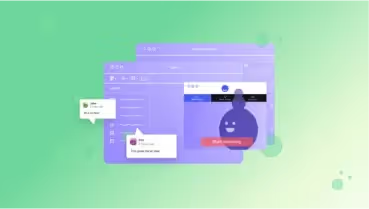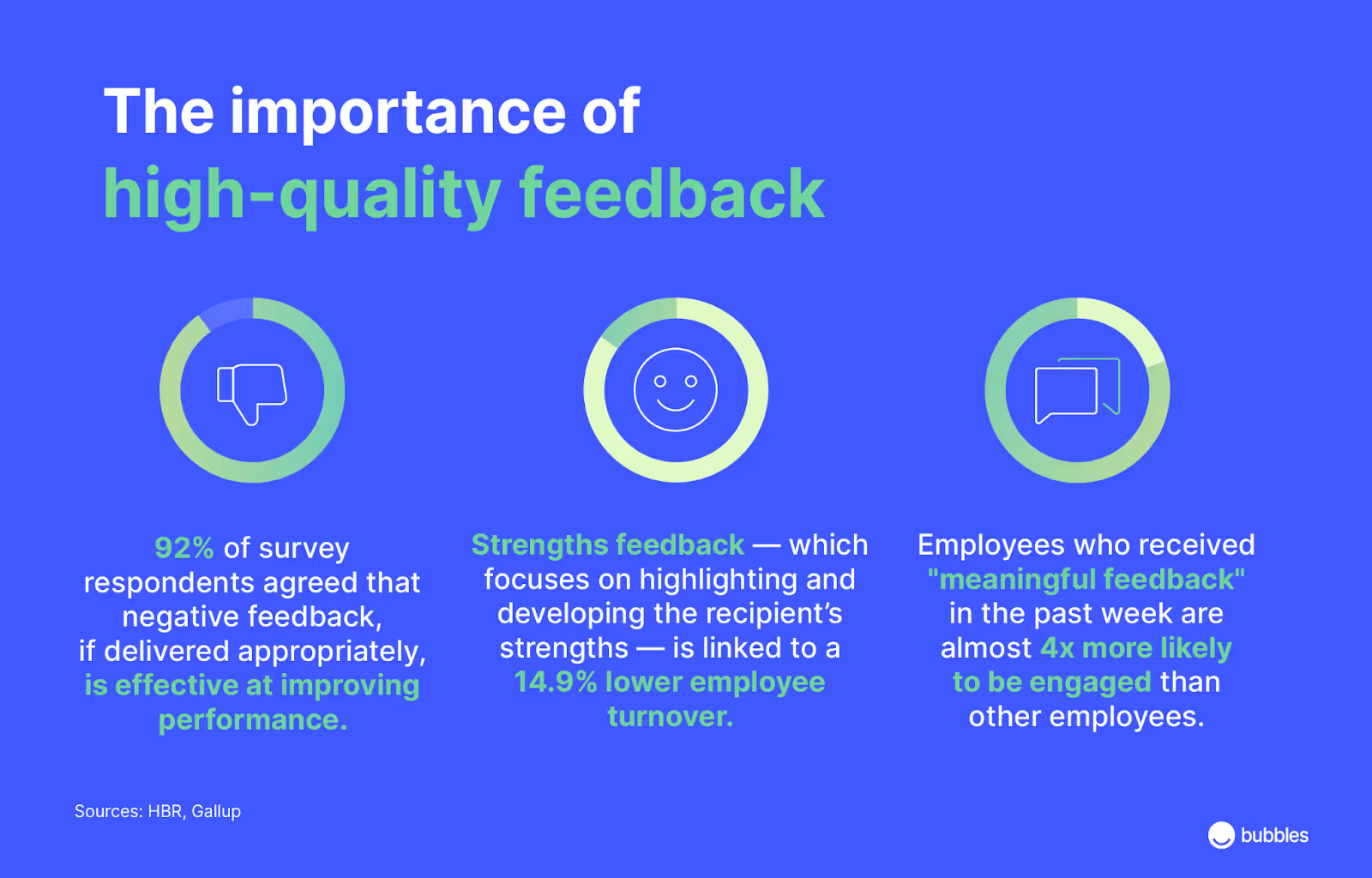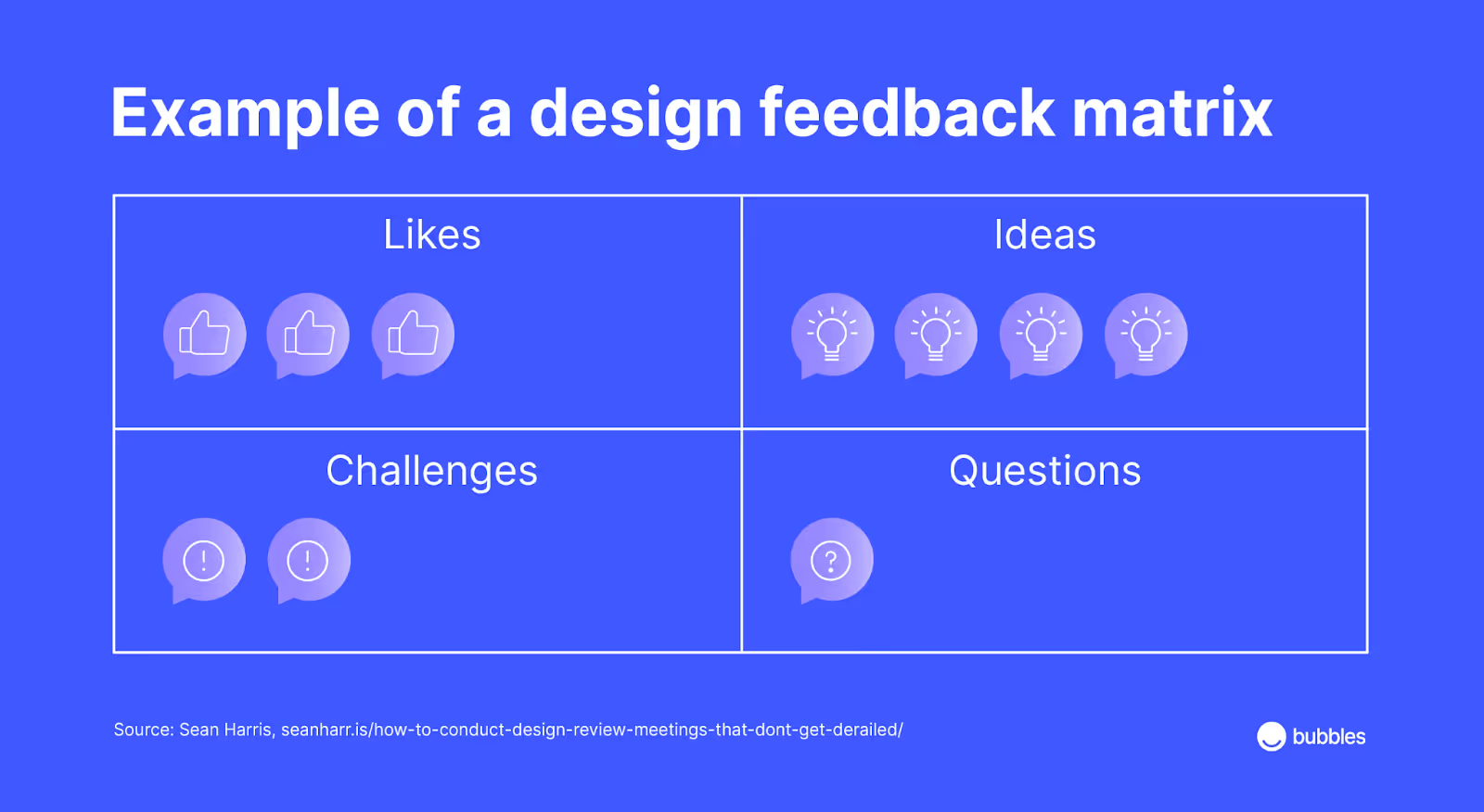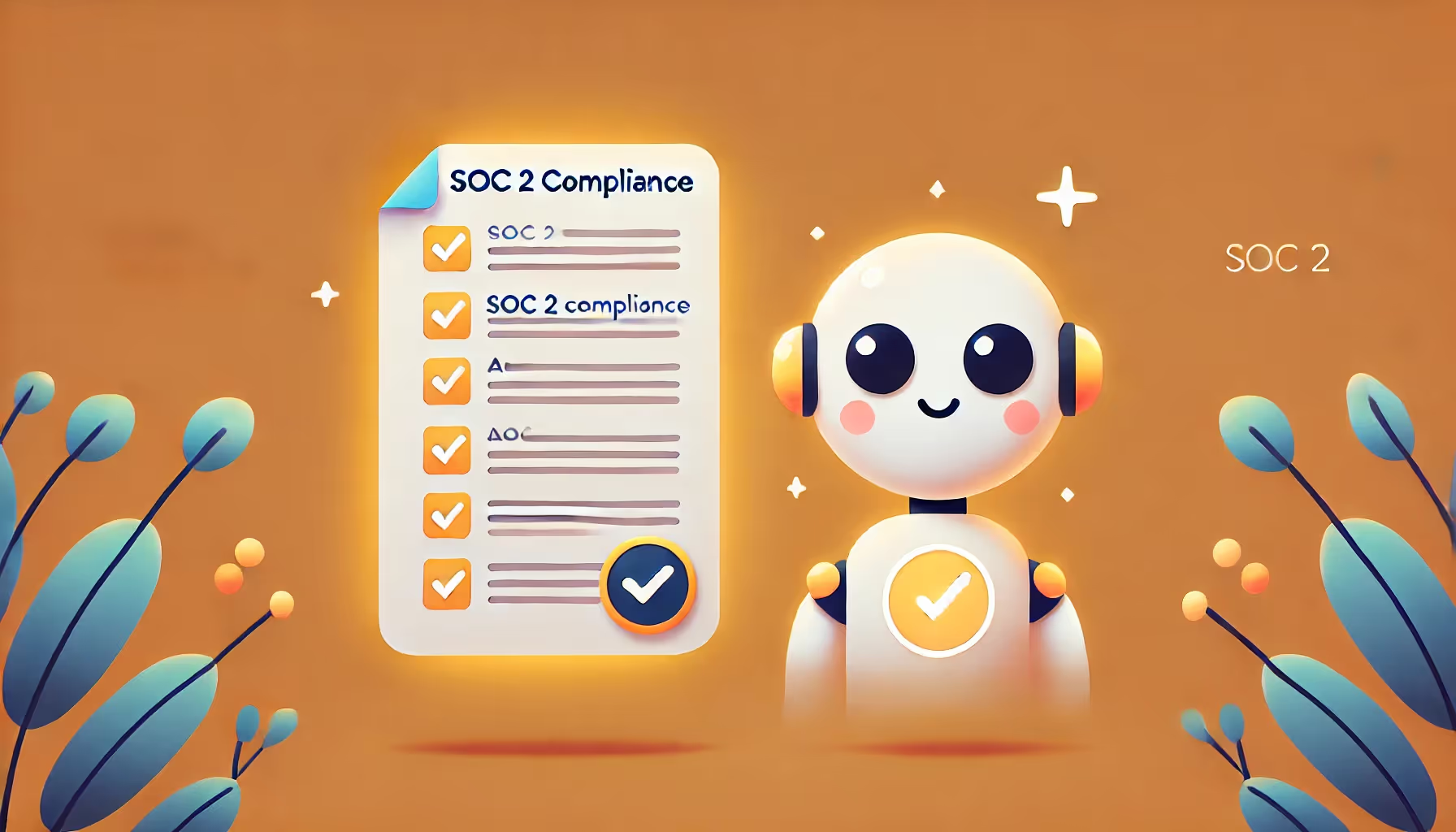
Design Review Meetings: How to Run Them in 2024
Design review meetings don’t have to be a collaboration nightmare. With the right tools and strategy, your design reviews can be much more efficient.
Design review meetings are an integral part of being a designer — unfortunately for creatives, most of whom would probably be quite happy to never attend another meeting again.
Having successful design reviews and getting meaningful feedback means learning how to present (i.e. sell) your work, facilitating the meeting, and asking the right questions to elicit thoughtful and constructive input from the key stakeholders.
Being able to conduct efficient design reviews allows designers to be more effective and impactful at their jobs, reach alignment faster, and ship powerful designs that are up to spec, every time.
In this article, you’ll learn:
- What a design review meeting is
- How the design review process works
- The different types of design reviews
- The key pitfalls of design reviews — and how bubbles solves them
- How to run effective design review meetings
- How using the right tool can help you run more efficient design reviews
Let’s dive in!
What is a design review?
In a nutshell, a design review is a meeting in which a marketing or product design (or set of designs) is discussed and assessed using criteria such as whether the design is suited to the target user personas, whether it solves the product, and whether it embodies the brand successfully.
During a design review meeting, the designer(s) presents their design(s) to the other meeting participants. This gives project managers, product owners, engineers, marketers, or content managers, and other relevant stakeholders an opportunity to ask questions and offer feedback.
The objective of a design review is to achieve creative alignment to ensure that the final version of the design successfully addresses the goals of the product and the business.

What’s involved in the design review process?
Whether the design asset you’re reviewing is marketing collateral or a new product design, the design review process is a key part of the creative collaboration process.
An effective design review enables cross-functional teams to get up to speed on the project’s progress, provide the designer with critical feedback, and reach greater alignment.
While every organization has its own way of doing things, here are some of the steps a typical design review process may include:
- Preparing for the review: The designer or design team gets ready for the review process by preparing their design presentation (or design package) and sharing any materials that attendees may need to peruse in advance. If the review is to take place synchronously, they also set the meeting date, schedule it, invite meeting participants, and outline the agenda items.
- Presenting the design: The designer (or lead designer, if the project involves a team) acts as a facilitator and presents the design work to the other stakeholders. This includes contextualizing the design, walking participants through the user experience, and explaining the creative process and decisions involved. The designer may also provide guidance in terms of what kind of input they’d like or provide a feedback matrix.
- Collecting design feedback: The team now has an opportunity to ask questions about the design concept and execution and give their input. Usually, some discussion (and debate) ensues. If the review takes place in real-time, someone is tasked with taking meeting minutes (ideally not the designer — they need to focus) and documenting action items.
- Making design changes: After the review, the designer reviews the feedback (or meeting minutes) and reflects on how to implement the team's suggestions and ideas, prioritizing feedback points that impact business value. Next, the designer applies these changes to the current design.
- Follow-up review and design approval: Once the designer has incorporated the feedback from the preliminary design review, the designer shows the updated design in a design review board meeting. There may be another round (or multiple rounds) of revisions before the final design is approved.
Of course, this is what it looks like when things run smoothly — which they sadly often don’t.

Different ways to run design review meetings
There are various different ways to run design review meetings, but ultimately, the goal of each is to promote cross-functional collaboration that leads to a shared clarity around the direction the design should take.
The roundtable discussion is probably the most commonly followed format for synchronous holding design reviews. Generally, this looks like everyone involved sitting around a table (yes, literally) and adding their two cents.
This format allows team members to collaborate and freely exchange ideas and solve problems in real-time. Ideas and challenges can be discussed in depth until all stakeholders are aligned and agree on the correct course of action.
Another common way to conduct a synchronous design review is the feedback workshop. In this format, the designer presents their work to the group and the rest of the participants jot down questions and comments they’d like to raise. After the designer has completed their presentation, they open the floor to other attendees to “workshop” the design.
Feedback workshops often use feedback matrices like the example shown below to gather insight from all the review participants.

This approach involves each group member writing down all their positive comments, questions, ideas, and concerns or challenges. The meeting facilitator (or designer, if they’re not the same person) can then review these notes and ask participants to elaborate on their comments.
The key pitfalls of design reviews — and how bubbles solves them
Each of the design review formats outlined above has its limitations. That’s why we’ve come up with a way to make the process much simpler, regardless of whether you work remotely or in an office.
Don’t worry, we got you.
TLDR: Run your design reviews asynchronously. Use bubbles to nail it.
Challenge 1: Design reviews require multi-functional attendance, but it can be difficult to schedule a meeting with so many people. Key decision makers might not always be able to attend. This can lead to additional back-and-forth if all stakeholders aren’t present and in alignment.
Solution: Bubbles solves this by allowing you to share the design and gather feedback asynchronously
Challenge 2: Synchronous design reviews don’t promote thoughtful feedback because people are sharing ideas 5 minutes after seeing the design. Synchronous design reviews can get derailed if the designer is not a skilled facilitator and meeting participants go off-topic. Plus, more extroverted collaborators may dominate the conversation, while quieter team members don’t get a chance to contribute, and neurodiverse peeps struggle to resist zoning out.
Solution: Bubbles solves this by allowing people to digest the creative at their own pace and take their time giving thoughtful feedback, plus it gives everyone a chance to be heard.
Challenge 3: It’s difficult to capture feedback from so many people and make sure you got it right. Attendees have to write down their ideas and questions — or remember them — until the group discussion begins. Plus the designer has to take notes or rely on someone else’s meeting minutes.
Solution: Bubbles captures all the feedback in context, which means no more notes getting lost in translation.
Challenge 4: In real-time design reviews, it’s difficult to have a real conversation about the feedback and get to a decision because you can't offer alternative solutions and discuss every idea in detail — not unless you want all your colleagues to resent you, anyway.
Solution: With bubbles, you can reply to the feedback with an alternative design and go back and forth until you reach a decision — without keeping everyone involved in a looong meeting.
How to run effective design review meetings in 7 steps
Let’s face it, most people suck at giving feedback. And more than that, most non-designers don’t have a clue how to design feedback, or even what aspect of the design to give feedback on!
Want to avoid the dreaded “This isn’t right, but I’ll know it when I see it” conversation?
Get better at running design reviews.
Help your reviewers out by using the right tools, being prepared, setting the scene, and asking for specific input.
Here’s how.
1. Define the feedback space (Use the right tools)
Design review meetings are pretty much indispensable when it comes to finalizing designs that result in successful products.
Remote work and asynchronous collaboration are now mainstream, which means it’s more important than ever to get the review and feedback collection process right.
For best results, you want to control the environment in which the review takes place, so you don’t need to collate feedback from fifty different emails and Slack messages, and project management tools.
And the best way to control the review environment is by using the right tool.
Enter bubbles.
With bubbles’ interactive screen recording tool, you can run efficient design reviews using screen, video, and audio messages so you can present your designs and get detailed, timestamped feedback, all in one place.
Unlike other screen recording tools, bubbles allows multiple reviewers to comment on specific sections of your design presentation (using timestamps and screen annotation). Plus, they can use text, audio, or even screen recordings to leave these comments. Plus, they can view and respond to other collaborators’ comments, minimizing repetition and bringing those brainstorm-esque conversations online.
Watch the video below to see how you can use bubbles to request design feedback:

This GIF shows a designer using bubbles to run a micro epic — notice the little bubbles showing the team’s annotations on the playback bar at the bottom of the screen.
Additionally, bubbles captures the conversation, so everyone is aligned on what was discussed and what will be addressed.
2. Plan and prepare for the design review
It’s important to show up for the design review prepared. After all, it is a presentation. Prepare your main talking points, systematically address each one, and try to anticipate questions and concerns.
Identify appropriate reviewers and share the design review bubble with them for viewing and input (or invite them to the meeting if your workplace insists on doing synchronous reviews).
Developing a consistent design review format is crucial. Being consistent means everyone knows what to expect, which improves collaboration and productivity. This also ensures that no steps get skipped.
3. Provide context
Begin your presentation with a brief agenda that explains the goal of the meeting and sets everyone’s expectations. Outline what you’ll be sharing and what kind of comments you’re looking for.
Don’t gloss over that last part. Make it clear to your reviewers exactly what types of feedback you want from the review.
Explain the background and the story of the design first. Answer the following questions:
- What’s the main objective (or problem statement) of the design draft you’ve worked on?
- How does the design align with the project’s strategic goal?
- Who is the target group or audience for the design? How does this design speak to that audience?
- What are the potential use cases? (If it’s a product design)
- What does a potential user experience or customer journey look like? (if relevant)
With bubbles, you can record your screen as you use whatever design tool you prefer, so feel free to use a virtual whiteboard to show your process if Figma is your drug of choice.
4. Present your design(s)
Now that you’ve set the scene with some important context, walk your reviewers through your design(s). Briefly discuss any design themes or principles influencing the work, explaining how you believe your work embodies these principles.
For example, some principles guiding your design may include “accessible,” “inspirational,” and “tongue-in-cheek.”
Remind the participants that you’re seeking feedback as to how the design(s) succeeds or fails as a solution to the stated “problem,” meets the business’s objectives, and aligns with the project’s specified design principles.
5. Ask the right questions
Don’t just ask your colleagues “how they like your design”. Ask them specific questions, such as:
- What is memorable about this design?
- Who would this design appeal to?
- How could this design be more simple?
- Is there anything confusing about this design?
- What problem does this design solve?
- What feeling does this design evoke for you?
To keep it simple, you can develop your own feedback matrix or question templates for various types of design reviews.
Share these with participants alongside the bubbles link so reviewers can refer to them as they watch your presentation and consider what to put their comments.
6. Review feedback and outline the next steps
After the rest of the stakeholders and decision-makers have had a chance to engage with your design review and leave comments, it’s time to check — and respond to — the feedback you’ve received.
With bubbles, this means reviewing the time-stamped comments (or comment threads) on your design review video and responding to them. (Isn’t technology great? Now you can have real creative conversations — no matter what country or time zone you’re in!).
Your next step: prioritization. Distill your feedback into action items and take action.
7. Iterate and repeat
This step kinda speaks for itself, doesn’t it? Apply the feedback you’ve received, rinse, and repeat.
Try bubbles for efficient async design reviews

Design review meetings are a vital part of product development, and we’re pretty sure they’re not going anywhere anytime soon.
With bubbles, your design review meetings will take much less time to plan and execute, you’ll be able to discuss your designs and motivations uninterrupted, and, most importantly, you’ll be able to gather higher-quality feedback, in-context, while allowing everyone involved to respond in their own time.
Best of all? Bubbles is totally free! Try our free Chrome extension and see how quick and easy it is to get started.
Make your
meetings matter
Loved and trusted by 100,000+ users:
- Automatically Record and Transcribe Meetings
- Extremely Accurate Notes, Summaries, and Action Items powered by AI
- Works with Zoom, Google Meet, and Microsoft Teams
- Save time and follow-up with quick async videos
Simply connect your work Google or Microsoft Calendar to get started.
Collaborate better with your team
Get your point across using screen, video, and audio messages. Bubbles is free, and offers unlimited recordings with a click of a button.
.avif)
Collaborate better with your team
Get your point across using screen, video, and audio messages. Bubbles is free, and offers unlimited recordings with a click of a button.
.avif)













.avif)